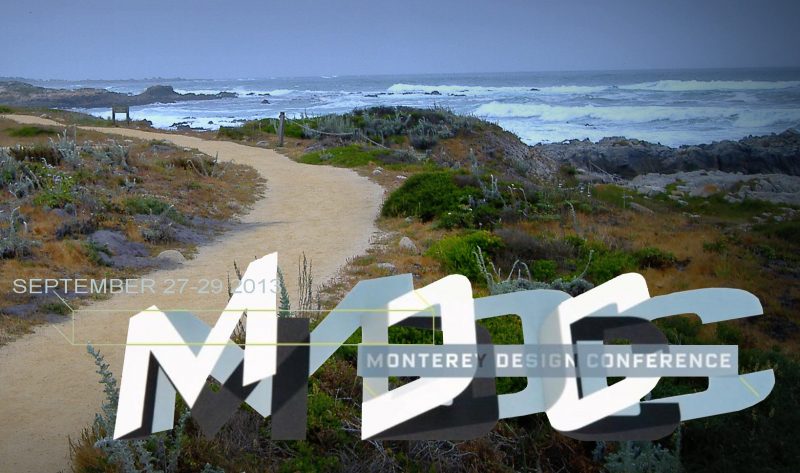Monterrey Design Conference
For those of you who attend The Monterey Design Conference, you know how illuminating it is, one of those rare instances where professional development is an actual intellectual exercise. 2013 was no exception. The thing that stands out in my mind was the degree of subtlety that was on display and the emphasis on the phenomenology of space in opposition to more formal or graphic expressions. Perhaps this is best characterized by the “spirit in the prosaic” or the exercise of finding “the great within the small”, and by so doing “elevating the ordinary to the status of architecture” as Marlon Blackwell explained. Listening to him talk I realized that there is a fundamental humility that comes from working in less urbane areas of The United States and that it serves a less esoteric approach to design. Marlon works with small budgets in modest locations and creates sublime results without any of the pretention that is associated the academic practice of architecture.
Brian Price’s brief presentation followed a similar trajectory, a new and more experimental practitioner, he has already realized that we are often best served by “working through subtraction…. re-framing familiar things.” He was eloquent as he discussed the need to find new forms of engagement, a very important comment on the nature of architectural practice in this, still new, century.
Anne Fougeron’s work is a testament to dedication and persistence. Her lecture titled “Work: A Decade” charted a trajectory in both scale and invention that is something to aspire to. I was surprised to learn about her education as an art historian, but knowing that allowed me to understand her work through a new lens. She made references to Dan Flavin and James Turrell, artists who work in the abstract medium of light. This has direct implications for architecture where the medium is space, a material enclosure that has density and presence. Sealed containers that reject, limit, modulate or allow the introduction of light (and other environmental phenomena) as a fundamental “function.” Only someone with an understanding of, and appreciation for, art can appreciate the power of working with this all-present, but immaterial medium. It clearly informs her approach to architecture which is more about being than seeing. A very important message in this era of instantaneous image circulation and consumption.
I had the unique opportunity to attend The Monterey Design Conference at the same time as I was attending The Carmel Ideas Festival. The Ideas festival is a gathering of authors, some as well known at The New York Times’ David Brooks or the author Jane Smiley. They each speak for twenty minutes to an audience of interested lay people about a diverse set of subjects. As you might expect, they are very good at delivering their thoughts in a concise and compelling fashion. Without being overly critical, I was left with the impression that we, Architects in general, need to get a lot better at communicating our ideas. As wonderful as the projects that were presented were, the presenters often fell into simple narration of the images on the screen, sometimes losing track of the rhetorical agendas that the titles and introductions to their talks suggested.
With that criticism in mind, the highlight of The Conference for me was the Saturday session with Jack MacAllister. Jack spoke for almost an hour, in front of a single image, without notes and without allusion. Granted he has sixty years of experience to draw from, but his “Top 10 list for Architects” was both valuable and entertaining. His common sense advice was, all too often overlooked, is the sort that can only come from a deep and varied career. The way he told his story, and I use the word story intentionally because I am convinced that we need to become better story tellers, made his professional trajectory easy to comprehend. Working from the details at The Salk Institute, to founding firms, to advising, his impact has become larger and larger as he has touched more and more people with his knowledge and wisdom. At this late stage, he is a curator of architects, perhaps more influential than ever. His easy, unscripted, communication underscored that message.
The Conference was a success, and reflecting on it, I have to inquire about the agenda of the organizers, Larry Scarpa, Tim Culvahouse and Robert Ivy among them. Are these thought leaders working to help to usher in a new era in our field? With lecture titles like “Material/Immaterial” with work by Odile Decq whose projects evidence the expressive potential for small modulations within a regulated field, I believe that the message is clear. Space is the medium in which we work, phenomenology is the mode of experiencing that medium and whether or not one can find the language for expressing it, everyone responds to it. Architectural discourse has been on a juggernaut from form follows function, less is more, structuralism, post-modernism, to de-constrcutivism and out the other side. Perhaps The 2013 Monterey Design Conference was styled to remind us about what the real “stuff” of architecture is. To demonstrate that there is ample intellectual potential in contemplating and working from that “stuff” and to re-focus our endeavors in this time of growing environmental concern. There has never been a moment where the world needed our thoughts and talents more, let’s hope we can rise to that challenge.
Ross Levy AIA LEED BD&C CGBP


